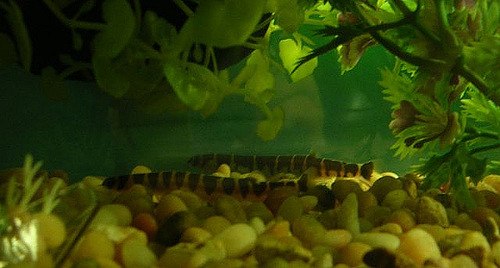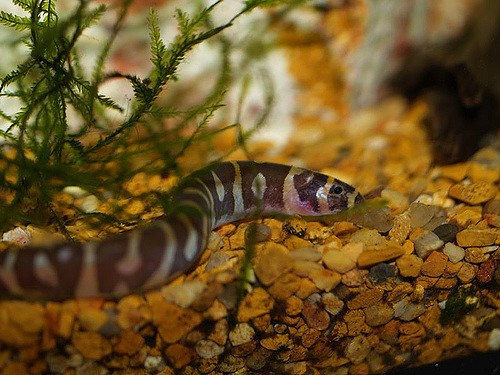Whether you’re a beginner to fish keeping or you’re looking for some colorful new additions to your tank, kuhli loaches (also Anglicized as ‘coolie’ loaches) are a good species to begin with.
Though they look like eels, they are classified instead alongside carps and minnows.

Contents
Kuhli Loach Appearance
Kuhli loaches are most often caught in the tropical fresh waters of Indonesia, Malaysia, Java, and nearby areas. They are one of several captivity-friendly types of loaches, and are usually striped in varying widths of black against orange or pink undersides.
With proper care, it is not unusual for Kuhli loaches to reach fourteen years of age.
They fall within the size range of two to five inches as adults, with most averaging around three.
Kuhli Loach Personality
Kuhli loaches are nocturnal when isolated. With a thriving community of ten Kuhli loaches or more, they will be active in the daytime as well.
Your Kuhli loaches can spend an incredible amount of time in hiding, but thrive and become far more sociable in groups of ten or more.
As long as there is appropriate space, there is no such thing as “too many” of these fun-loving creatures.
Kuhli loaches are a very communal species of fish that dwell on the bottom of freshwater streams in their habitat of origin.
They burrow in the sand and filter it through their gills to extract food such as insects and other small creatures, as well as pieces of plant material.

They enjoy hiding under plants, pieces of wood, and other areas of coverage. Your Kuhli loaches will probably spend the first few weeks in hiding, especially in smaller numbers.
Like all loaches, Kuhli loaches are believed to be good predictors of the weather due to their sensitivity to atmospheric change.
Your new loach friends have certain preferences and needs for their aquatic paradise. They do not do well in environments with aggressive tank mates, but they are generally peaceful fish and can get along with just about any other species that will not attack them or that they do not consider prey.
Because they are carnivores, it is ill-advised to keep species that they consider prey as pets in the same tank. Small shrimp such as cherry shrimp will not do well with Kuhli loaches; they will eat them.
They also have a taste for eggs and fry fish, so other species you are trying to breed may not have surviving offspring with Kuhli loaches roaming.
They should be housed together with fish that inhabit the top or middle of the tank, rather than other fish that will compete with them for space on the bottom. Some popular tank mates are betas, angelfish, tetras, and red-tailed sharks.
Here’s a video of a Kuhli Loach in a community tank.
Health Problems
There are several health problems that Kuhli loaches are susceptible to. Because of their soft bodies and faint scales, they are more prone to diseases such as ichthyophthirius (commonly known as “ich” or “ick”) than other fish.
They may also contract parasites that cause them to lose weight, often called “skinny disease.” Both of these problems can be treated with medication, but Kuhli loaches are more sensitive to ichthyophthirius medication than other fish and should only be given half of the usual amount.
Currently, there are not many veterinarians who specialize in fish, but if possible, any health concerns should be addressed with a veterinarian.
Experienced keepers may also have advice and experience figuring out what is wrong. Surgery should never be attempted by someone who is not a licensed veterinarian with painkilling aids.
Breeding
There are conflicting reports on whether Kuhli loaches are easy to breed or not. Your average Kuhli loach is caught from the wild, as they are still plentiful where they come from.
If you want to breed them, you will most likely have to invest in a separate breeding tank so that you can induce the conditions which trigger them to spawn eggs. This will also keep prey species from preying on the eggs and fry.
During spawning season, female Kuhli loaches’ eggs will glow a visible green through their skin, and they will be larger around the front. Off season, you may be able to identify male Kuhli loaches by their (typically) more pronounced pectoral mass.
For your breeding tank, you will want to keep a keen eye on the water. Change the filter regularly, as well as scoop out some amount of old water in the tank and switch it out for new.

This will help keep the water fresh for them, and closer to the wild habitat conditions that would normally trigger spawning.
The tank should have floating plants with roots for them to lay their eggs on. Once the females appear to be full of eggs, some breeders recommend spraying the tank with pure, fresh water on an evening when rain is forecasted, to trigger their spawning instinct.
The youngest known Kuhli loaches to breed were twelve months old, though it is suspected that most do not reach sexual maturity until two years.
Like most species, not just any Kuhli loach will do for another Kuhli loach. What kind of Kuhli loach is most in demand on the singles’ market is a mystery that your average human is not going to have insight into, so this is yet another reason to keep them in large groups.
Kuhli Loach Care
Tank Requirements
Kuhli loaches are not your typical bottom feeders. While “bottom feeder” usually invokes images of algae eaters, Kuhli loaches are a different type of bottom feeder who perform a different task in your tank.
Kuhli loaches will filter food out of the substrate of your tank, keeping it nice and tidy.
Kuhli loaches do not have very strict tank requirements, but since they are bottom dwellers, the area of the bottom of your tank is more important for them than the total volume of water.
They require, at a minimum, a 20 gallon tank with as much floor space as possible, and will quickly outgrow anything smaller; a long rectangular tank is the ideal shape.
Caves, plants, and other types of hiding spots will be appreciated by these loaches. In fact, having more hiding places results in them feeling more secure in their environment, and causes them to hide less rather than more.

They will need to be kept in a tank with a sand substrate, as they will burrow into the sand and filter it through their gills to eat.
This is an essential function of their digestive system. Rough rocks and gravel can be a danger to them, as it can cause harm when they are engaging in natural burrowing behaviours.
They are very talented at squeezing out through small spaces. Their tank needs to be tightly covered or you might end up with a Houdini situation, or worse: they might get caught in a filter.
Water requirements
In their native environment, they live in acidic water. A pH of 5.5 to 6.5 is ideal, but they can tolerate a pH of up to 7.
The hardness is a more important aspect of the water quality for them than the pH is. They prefer to live in a soft to medium-soft water, ideally with a hardness of 5 dGH.
Since they are tropical fish, they require a temperature of 73°F to 82°F.
They prefer frequent water changes, but should not be introduced to a brand new tank when it’s avoidable because they can easily become ill with “new tank syndrome.”
A water filter will go a long way in maintaining the tank and keeping them happy.
Tank Set-Up
Kuhli loaches can be sensitive to dramatic changes in the water they inhabit, so it is important to act slowly and gradually when introducing them to the tank.
First, float them in your tank in the bag they came in for 30 minutes so that they get used to the temperature. After that, remove 10% of the water from the bag and replace it with water from your tank, and then wait 20 minutes.
Do this four more times until the water in the bag is about half their original water and half your water. This will help them get used to the chemical conditions in your tank.
After this, you can gently release them into the tank.
Kuhli Loach Food
Since Kuhli loaches are mostly carnivorous, they will need fish pellets supplemented with appropriate prey. They will respond well to a combination of pellets, flakes, frozen, and live food.
If they are housed with other fish, it is important that some of the pellets be designed to sink to the bottom so that they are more likely to be the ones successfully scavenging it.

They will find live prey more satisfying than pellets. Prey that they enjoy include blood worms, daphina, black worms, cherry shrimp, and brine shrimp.
Prey that prefer the top or middle of the tank will generally not be of much interest to our bottom-dwelling Kuhli loaches.
Kuhli loaches also benefit from having some plant material in their diet; many people enjoy feeding them small pieces of vegetables such as spinach, cucumber, and peas.
It is important to give them extra feed when first transitioning them to your home. Not only is adjustment to a new tank stressful for them (thus necessitating extra nutrients), but they will also need to learn and adapt to their new feeding time.
Many people prefer feeding them at night, because that is when they are the most active.
Keeping Kuhli Loach
Kuhli loaches are a fantastic hobby fish for beginners and experienced fish keepers alike.
They make a great addition to the average aquarium environment.
Do you have any Kuhli Loach?

